Roof vent pipe flashing is a material used to seal the gaps around vent pipes that pass through your roof. It creates a waterproof barrier that prevents water from leaking into your home where the pipes penetrate the roof. Without proper flashing, water can seep through these gaps, leading to serious problems like water damage, mold growth, and costly repairs.
If you don’t use roof vent pipe flashing or if it’s installed incorrectly, your roof is at risk of leaks, which can weaken the structure over time. Water infiltration can damage the roof deck, insulation, and even the interior of your home.
I’ve reviewed nearly 10 different options and selected the best 5 roof vent pipe flashing products for you.
What is Roof Vent Pipe Flashing?
Roof vent pipe flashing is a specialized roofing material installed at the base of vent pipes to create a watertight seal between the pipe and the roof. Vent pipes pass through the roof to allow exhaust or air circulation, and they are commonly used for plumbing, heating, or ventilation.
If the flashing is not properly installed, water can leak into the gap between the pipe and the roof, causing water damage and promoting mold growth.
Why Roof Vent Pipe Flashing is Important
Preventing Water Leaks
Roof vent pipe flashing creates a barrier that prevents water from entering the roof through the gaps around vent pipes. Properly installed flashing protects both the roof deck and the interior of the house from water infiltration.
Extending Roof Life
By preventing leaks, flashing protects the roof deck, underlayment, and insulation, helping to extend the overall lifespan of the roof.
Energy Efficiency
Properly sealed roof penetrations reduce air leaks, improving the energy efficiency of the home. This can lead to lower heating and cooling costs.
Maintaining Aesthetic Appeal
Well-installed flashing provides a clean, finished look to the roof, preserving its visual appeal and enhancing the overall appearance of the home.
Types of Roof Vent Pipe Flashing
There are several types of roof vent pipe flashing materials, each with its own advantages and disadvantages. The best choice for your roof will depend on factors such as roof type, climate, and budget.
1. Rubber Flashing
Description: Rubber flashing, often made from EPDM or silicone, is a flexible and durable material designed to fit snugly around vent pipes. It adapts to various roof pitches and pipe sizes.
Advantages:
- Flexible and easy to install.
- Resistant to UV rays and weather conditions.
- Fits a variety of pipe sizes.
Disadvantages:
- May deteriorate over time with prolonged exposure to the elements.
- Limited color options.
Best For: Residential roofs with standard vent pipes, especially in moderate climates.
2. Metal Flashing
Description: Metal flashing, typically made from aluminum, galvanized steel, or copper, is known for its durability and long lifespan. It provides strong protection against the elements.
Advantages:
- Highly durable and long-lasting.
- Offers excellent aesthetic appeal with various finishes.
- Fire-resistant.
Disadvantages:
- More expensive than rubber flashing.
- Requires more skill for proper installation.
Best For: Homes in harsh climates or historic buildings where a high-end, long-lasting solution is needed.
3. Plastic Flashing
Description: Plastic flashing, usually made from PVC or other synthetic materials, is lightweight and cost-effective, making it easy to handle and install.
Advantages:
- Inexpensive and lightweight.
- Resistant to corrosion.
- Easy to install.
Disadvantages:
- Less durable than metal options.
- Can degrade with prolonged UV exposure.
Best For: Budget-friendly projects in mild climates where durability is less of a concern.
4. Lead Flashing
Description: Lead flashing is a traditional material valued for its flexibility and durability. It can be shaped to fit complex roof contours.
Advantages:
- Extremely flexible and easy to shape.
- Long-lasting and resistant to weather conditions.
- Provides a classic, high-end appearance.
Disadvantages:
- High cost.
- Requires careful handling due to its toxicity.
Best For: High-end or historic restoration projects where both aesthetic appeal and longevity are important.
Top-Rated Roof Vent Pipe Flashing Products
Choosing the right roof vent pipe flashing is essential for ensuring a watertight seal and protecting your home from water damage. Here are some top-rated roof vent pipe flashing products, including details on their materials, features, pros, cons, and best applications.
1. Oatey 14052 Rain Collar
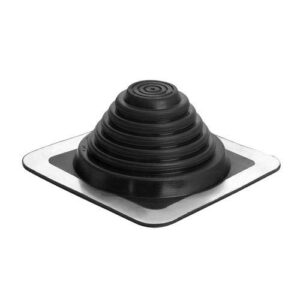
Material: Flexible rubber (EPDM)
Features:
- Fits over existing vent pipe flashing to provide extra protection against leaks.
- Flexible design accommodates a range of pipe sizes.
- UV-resistant material for long-lasting performance.
Pros:
- Easy to install over existing flashing.
- Provides added protection against leaks.
- Flexible design fits different pipe sizes.
- UV-resistant for durability in sunny climates.
Cons:
- Designed as a secondary layer of protection, so it may not be sufficient alone if the underlying flashing is severely damaged.
Best For: Homeowners looking to reinforce existing flashing with added leak protection, especially in sunny or variable weather conditions.
2. Flashers #1 Silicone Pipe Boot Flashing
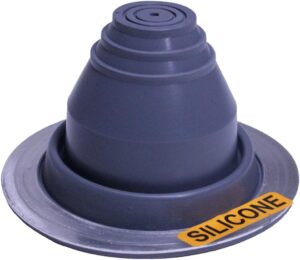
Material: Silicone
Features:
- Made from flexible, high-temperature silicone that can withstand extreme heat and UV exposure.
- Fits pipes of various sizes, from 1/4 inch to 5-3/8 inches.
- Easy to install with a self-sealing design that prevents leaks.
Pros:
- Withstands extreme temperatures, ideal for roofs with metal or high-heat materials.
- Flexible design for a custom fit around various pipe sizes.
- UV-resistant and durable in harsh environments.
Cons:
- Silicone can be more expensive than standard rubber or plastic options.
- Requires precise cutting to fit, which can be challenging for some DIYers.
Best For: Roofs in areas with extreme temperature variations or roofs with metal materials.
3. IPS Corporation 81763 3-in-1 Roof Flashing
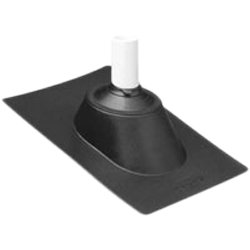
Material: Flexible plastic
Features:
- Versatile design fits multiple pipe sizes, reducing the need for different flashings.
- UV-resistant and weather-resistant materials for long-lasting durability.
- Compatible with various roofing materials, including shingles and metal.
Pros:
- Versatile design fits various pipe sizes.
- UV and weather-resistant for long-term durability.
- Easy to install with minimal tools required.
Cons:
- The plastic material may not be as durable as metal options in extreme weather conditions.
- Limited aesthetic appeal, especially on high-end or visible roofs.
Best For: Homeowners seeking a versatile, easy-to-install flashing solution for standard roofs.
4. DEKTITE DFE104B EPDM Pipe Flashing
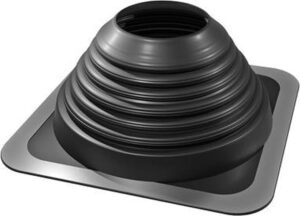
Material: EPDM rubber
Features:
- Flexible design fits various pipe sizes and angles, making it ideal for complex roof layouts.
- UV-resistant and weatherproof material for a long lifespan.
- Easy installation with a self-sealing design that provides a watertight seal.
Pros:
- Flexible and durable, accommodating different pipe sizes and roof angles.
- UV-resistant and weatherproof for long-lasting protection.
- Easy to install with a self-sealing design.
Cons:
- May require more frequent inspections in extreme weather conditions to ensure integrity.
- The rubber material may not match the aesthetics of all roofing materials.
Best For: Roofs with complex layouts, including those with multiple vent pipes at different angles.
5. Perma-Boot 312-3 Roof Vent Repair Flashing
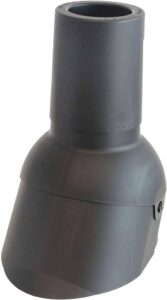
Material: UV-resistant plastic
Features:
- Designed for quick and easy installation over existing vent pipes to repair leaks.
- Durable, UV-resistant plastic for long-lasting performance.
- Fits standard 3-inch vent pipes and provides a secure, watertight seal.
Pros:
- Quick and easy to install over existing vent pipes.
- Durable and UV-resistant for long-lasting use.
- Provides a secure, watertight seal.
Cons:
- Limited to 3-inch vent pipes, so it may not fit all sizes.
- Designed for repairs, so it may not be as aesthetically pleasing as original installations.
Best For: Homeowners needing a quick repair solution for existing vent pipes.
